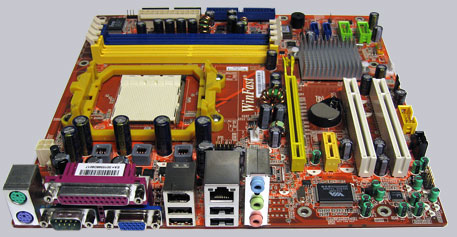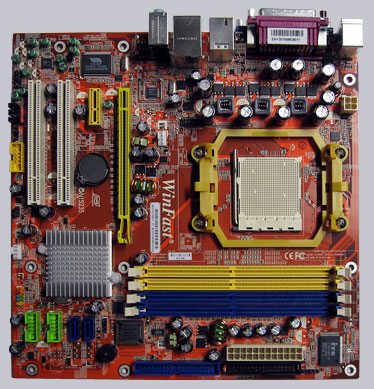
Result and general impression
++ The Foxconn MCP61SM2MA-ERS2H motherboard has a price of approx. 60 Euro (12/2006) and is thus in the lower price segment of the Socket AM2 motherboards.
MicroATX motherboards are unfortunately often less overclockable than ATX boards and are partially a nightmare regarding the overclock options. The Test of the new Foxconn WinFast MCP61SM2MA-ERS2H motherboard will clarify, whether this inexpensive board is an exception. Moreover the Review shows, whether the integrated GF6100 onBoard graphics solution is fast enough for current 3D games and if the board also has enough features to satisfy power users.
Equipment and other features …
The Foxconn MCP61SM2MA motherboard (model ERS2H) offers one PCIe 16x Slot, one PCIe 1x Slot and two PCI Slots for conventional extension cards.
Furthermore the Foxconn WinFast board offers only one IDE connector for up to 2x conventional ATA 133 HDDs and 2x SATA II connectors for newer HDDs.
Fortunately the memory equipment looks clearly better, since there are 4x DDR2 Slots to expand the DDRII memory up to 4 GB. The allocation for the DUAL Channel memory support is specified in the CDROM PDF manual and is shown by colored DDRII slots.
Besides, there are 4x USB 2.0 connectors at the ATX panel, two internal USB 2.0 plugs for 4 additional USB 2.0 ports, one IEEE1394a (400 MBit/s) port at the ATX panel, one optional internal IEEE1394a connector and one onBoard 10/100 LAN port with WoL support.
In addition it offers an IrDA port, two COM ports (1x optional) and one parallel port which is very important with HTPCs (Home Theatre PC) for LCD or G-LCD Displays.
The integrated onBoard RealTek ALC-861 soundchip allows 5.1 Surround sound and has an internal digital output with SPDIF out.
A special feature is the onBoard GeForce 6100 video support, however it is rather for office applications, because the performance is no longer sufficient for current 3D games. The direct comparison of the 6600 GT PCIe video card campared to the onBoard solution is shown above at “performance” and got with 3D Mark approximately 7-8 times difference.
BIOS and Overclocking …
Let us now begin with the most important BIOS options and the possible BIOS overclocking. With the Delete key one can enter the Award BIOS as usual to get all hardware settings.
Beside extensive memory timing settings and memory frequency settings from 200 MHz over 266 MHz and 333 MHz up to 400 MHz (DDR2 400/533/667/800), the BIOS offers a host clock from 200 MHz up to 300 MHz.
The HT (hypertransport) multiplier can be adjusted from 1x to 5x (200-1000 MHz), but the option for the CPU multiplier is missing completely. So it is not possible to lower the multi to achive a higher HT reference frequency.
It was nevertheless possible to succeed a stable reference clock overlocking up to the BIOS maximum of 300 MHz. For the AMD Athlon64 3000+ Socket AM2 CPU with the 9x multiplier lock it results in a nice CPU frequency of approx. 2700 MHz. For a HTPC the high overclocking becomes regarding to the heat rather rarely applicable, but the board might be interesting also for usual PCs in view of the favourable price.
Starting from a CPU frequency of 2300 MHz there was however a funny phenomenon, because the BIOS Post indicates not 2300 MHz, but began starting from 0 MHz! I’ve never seen a running processor with 0 MHz 😉

The screen shows e.g. 36 MHz instead of 2336 MHz.

However, this display is not by any means important, and is only shown very short before the operating system starts. Another bug in the BIOS was clearly more unpleasant, because the Vcore setting was unfortunately incorrect. Both bugs however certainly fixed in newer BIOS versions, so that it is worth to take a look into the Foxconn download support page.
In the BIOS are also some voltage adjustments, which were not necessary for the test CPU. Because the CPU and the chipset operated perfectly with the maximum host clock of 300 MHz.
Positively is also the fan control option in the PC Health menu, because this feature is very useful to get a low noise HTPC.
Result …
The Foxconn WinFast MCP61SM2MA-ERS2H Socket AM2 PCIe motherboard is well overclockable for an inexpensive Micro ATX board and is by no means a nightmare for overclockers. The equipment is quite appropriate to the motherboard size and should be sufficiently for a living room PC or for an usual office PC. 3D applications like newer games are not applicable with the onboard graphics solution and should be better used by a current PCI express video card in the PCIe 16x slot. There were some small BIOS bugs which should be fixed soon in newer BIOS versions.
All in all Foxconn offers hereby a fair cost-performance ratio for mid-range users. But I hope that Foxconn does not save expenses for a printed mainboard manual in the future, because a printed manual with all important connectors, pin layouts and BIOS settings is in my opinion indispensable for mainboards and should be offered additionally on CDROM.
Special thanks to Foxconn for their support.
**** All Socket 939 motherboard reviews since 01.11.2006 are based on an AMD Athlon 64 3000+ Orleans CPU, 1x (or SLI systems with 2x) Gigabyte GV-NX66T128VP Nvidia 6600 GT PCI Express video cards, 2x512MB Crucial Ballistix DDR2-800/PC2-6400 memory modules and the following software configuration: Microsoft Windows XP SP2, DirectX 9.0c, Forceware 81.85 video driver and 3DMark 2003. All benchmark results should only offer a comparison among themselves for a comparison.



